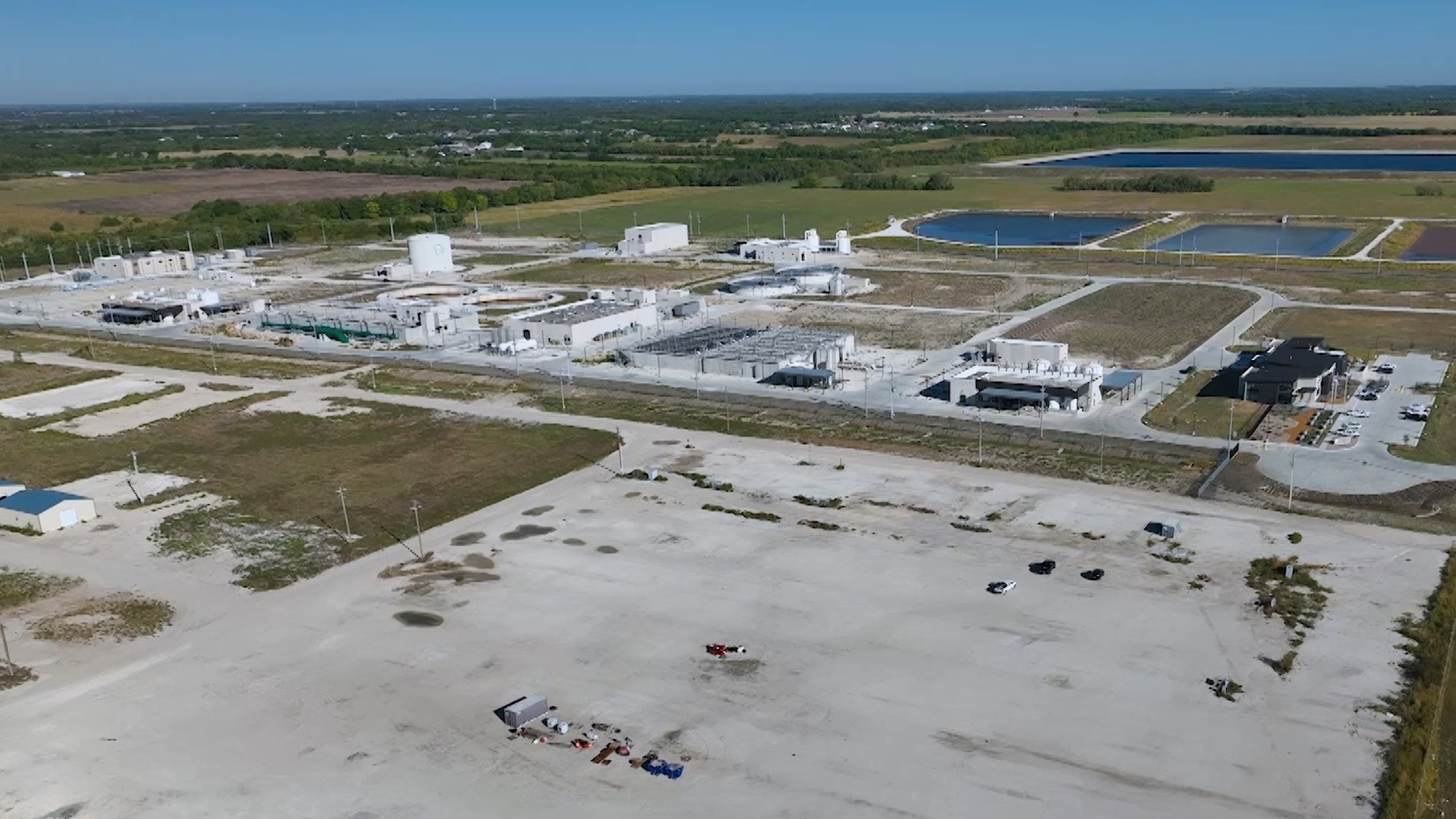Into the Headlines: Where does North Texas' water come from? Is there enough to supply the region's growth?
It takes decades of planning to ensure the DFW area has enough water in the future. It will also take citizens helping with the water supply as North Texas grows.

Water is something people can’t live without.
Literally.
That's why, during the summer months, water restrictions and concerns about the water supply frequently make headlines here in North Texas.
In recent years in particular, extreme weather and rapid population growth has driven up the regional demand for this precious resource.
That's why WFAA is digging back into the headlines, and taking a look at several factors that experts say will ensure the Dallas-Fort Worth area will have enough water to cover its needs for decades to come.
Chapter 1 Water Cycle
Much of the DFW area gets its supply from surface water, meaning reservoirs or rivers. Water from your sink, shower, toilet or hose -- it all comes from the same place.
The water cycle starts with rain falling into rivers and lakes. Through large pipes, water is then pumped into a water treatment facility, where it is cleaned to make drinkable.
Physical and chemical techniques at the water treatment facility remove the dirt and debris from the lake water. With help from gravity, sediments drop to the bottom. Water is then disinfected, and flows into a filter gallery.
Here, the water is tested to make sure it is safe for use. Once potable, the water is then distributed to cities, customers and homes.
Water waste must be cleaned and treated before it goes back into the waterways.
“It can be one to seven days to take the water from the lake and get it to the delivery points across the region,” said Jenna Covington, Executive Director at North Texas Municipal Water District.

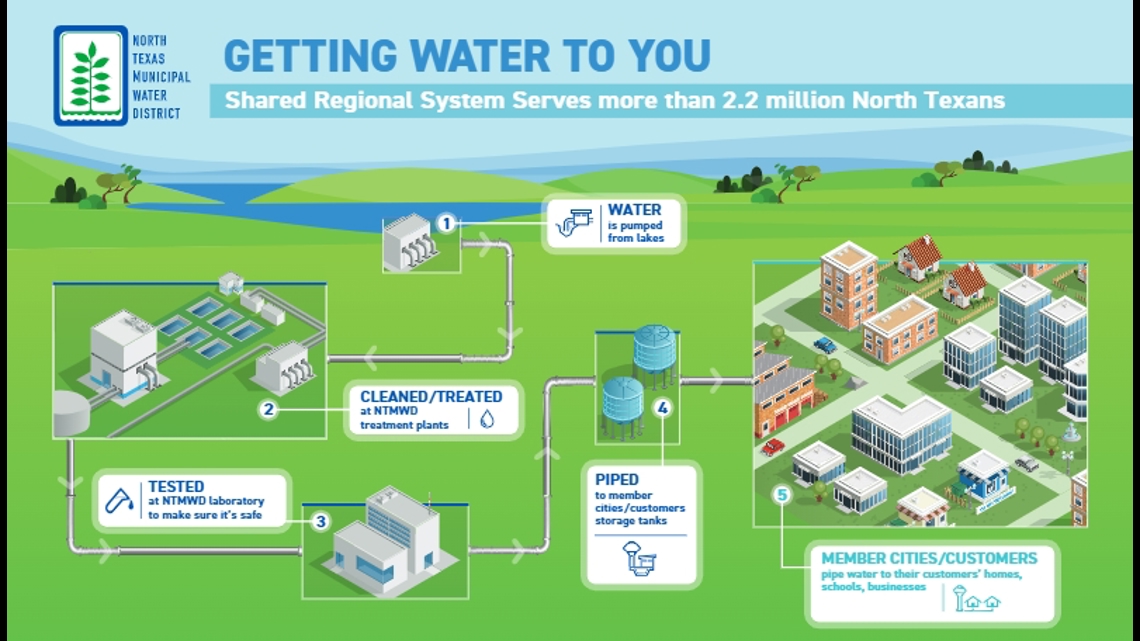
Chapter 2 New Lakes and Growth
North Texas is home to dozens of bodies of water, many of them manmade, with some of the more popular ones in the Metroplex being Lake Lewisville and Grapevine Lake.
It takes decades to plan and build these reservoirs.
The challenge at hand? How quickly the population in North Texas is growing compared to how fast these reservoirs can be introduced into the ecosystem.
For example, in Rockwall County, between 1992 to 2002, the population increased approximately than 321% -- from around 29,000 people to 123,000 people. And yet it takes more than three decades to plan and build a lake.
For the first time since the 1980s, there are two new lakes in Fannin County.
Bois d’Arc Lake is already open. Lake Ralph Hall is under construction.
Both of those lakes will serve communities in North Texas.
North Texas Municipal Water District and Bois D'Arc Lake
Bois d’Arc Lake is owned and operated by the North Texas Municipal Water District (NTMWD). It is located in Bonham.
In March 2023, the water district started treating and delivering water. In April 2024, the lake opened for recreational activities, including boating, fishing, hunting and picnicking.
The main purpose of Bois d’Arc Lake is to provide drinking water to the growing population that NTMWD serves.
“It’s growing very quickly," Covington said. "In fact, we have 55,000 people a year moving into our service area.”
Currently, NTMWD touches 10 counties, including communities in Collin, Dallas, Denton, Hunt, Kaufman and Rockwall counties. More than 2 million people get water from the NTMWD.
“Since [NTMWD] was founded in the 1950s to today, our service population has doubled six times,” said Covington.
NTMWD can produce 900 million gallons of water per day through its water treatment plants, Covington said. But that alone isn't enough to service our region entirely.

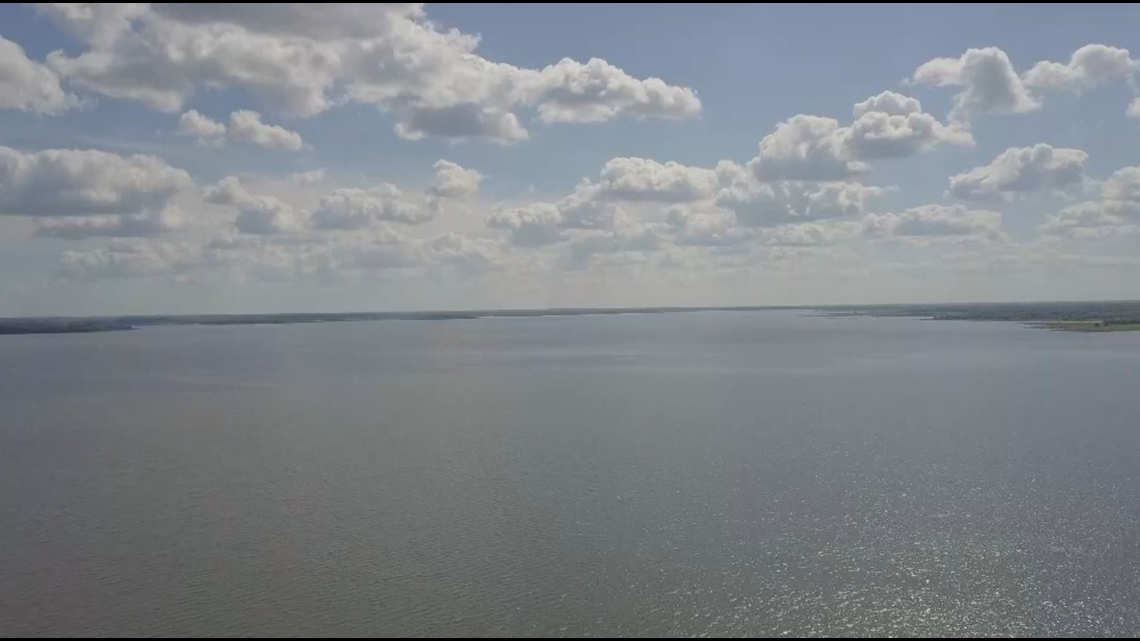
Upper Trinity Regional Water District and Lake Ralph Hall
Lake Ralph Hall is currently under construction in Ladonia. It's owned by the Upper Trinity Regional Water District (UTRWD).
The planning process for Lake Ralph Hall started in 2000. Its groundbreaking ceremony was in June 2021. The goal? To begin delivering water by the summer of 2026.
The project area is around 16,000 acres. The lake itself, once inundated, will be around 7,800 acres, similar to the size of Grapevine Lake.
UTRWD currently serves 29 cities and towns in Denton, Collin and Dallas counties, which is around 400,000 people.
“Projected growth over the next 50 years is a five-fold increase in our current supply that we provide, so we needed to move forward and find a new water source to meet demand,” said Larry Patterson, Executive Director of UTRWD.
Once filled and opened, Lake Ralph Hall will be able to serve 300,000 people and provide water supply, including reuse, of more than 50 million gallons per day.
“North Texas communities are gaining about 100,000 people each year," Patterson said. "That represents a real challenge to water suppliers and communities to meet that need."
As UTRWD is constantly planning for the future, it encourages residents to be good stewards of water too.


Chapter 3 Conservation
There are many ways residents can help save water.
Daily things like taking shorter showers, turning off the faucet while brushing your teeth or running the dishwasher only when it’s fully loaded are all impactful.
NTMWD also recommends people to turn their sprinkler systems off from Halloween through St. Patrick's Day.
Homeowners should also pay attention to any leaks that may be wasting water.
Another option is to replace grass with water-wise plants or xeriscaping. According to Texas A&M research, urban areas of the state use 25% of water supply for landscape and garden watering.
Xeriscape
Xeriscaping is a style of landscaping that requires little to no irrigation or maintenance. It utilizes native plants, which require less water than lawns. The native plants have a better chance of surviving harsh winters and summers. They also benefit by feeding the wildlife.
“With so many people with such big green lush lawns, that’s where we use the most water," said Jamie Klingenberg, co-owner of Gardens for Texas, a Dallas landscaping company. "So if they are really willing to decrease the size of their lawn, they could go a long way into conserving water."
Klingenberg has been in landscaping business for 20 years, and she’s seen a trend toward xeriscaping among her customers. She estimates half of her customers want to xeriscape their yards these days.
“There are a lot of different regions of Texas, so just because something is native down in Houston, it doesn’t mean it’s going to work in Dallas," she said. "You really need to pay attention to what is going to be native and zone for your specific region."
Klingenberg said that, with xeriscaping, there is lower maintenance.
“A garden like this doesn’t need to have someone come here weekly to mow a lawn, hedge, use a weed eater and cause a lot of noise,” she said.
She hopes every yard she xeriscapes will set a trend in the neighborhood in which that work is done.
There's financial benefits, too: According to Texas A&M, a household can save 30 to 50% on a water bill with xeriscaping.

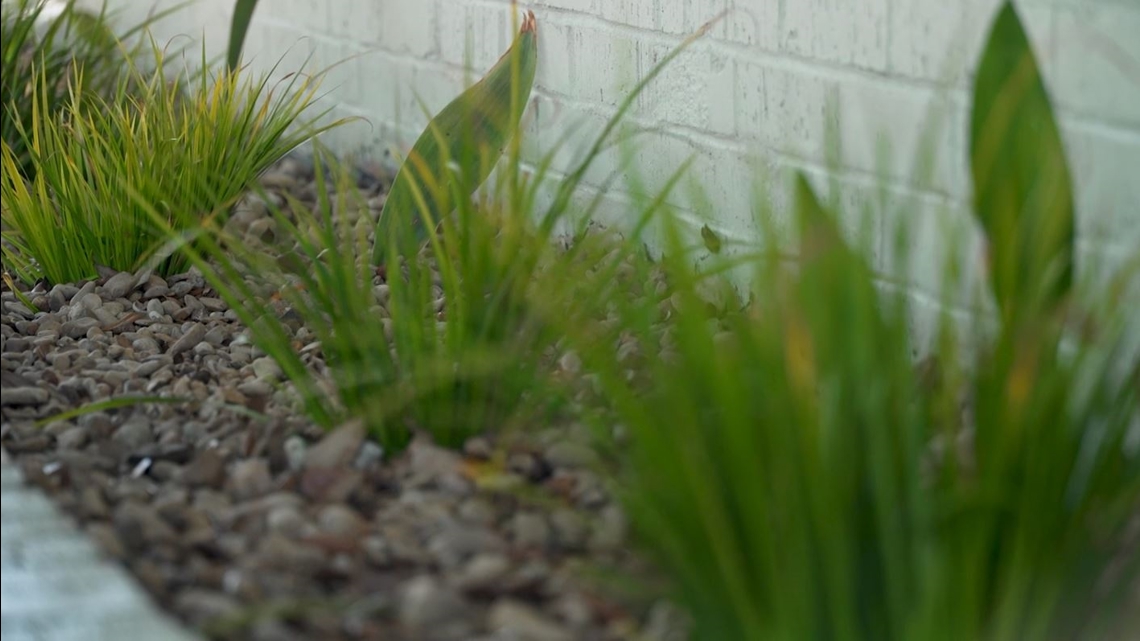
Rainwater Harvesting
Rainwater harvesting is also a way to save water. A rain barrel can repurpose rainwater in a low maintenance way.
“A lot of people start out with one rain barrel,” said Dotty Woodson.
She retired from Texas A&M Extension, where she taught water conservation.
“Water was a big issue in 1995," Woodson said. "It’s always been a big issue.”
According to Woodson, for every one inch of rain and one square foot of roof, around 0.6 gallons of rainwater can be collected. So, if you have a 1,000 square foot home, you can collect about 600 gallons of rainwater when it rains one inch.
That would give back around 375 toilet flushes or nine 10-foot-by-10-foot watered lawns.
If every home in North Texas had one rain barrel, Woodson said, everyone's water bill would go down.
It would help with other stresses in the water cycle, too.
"Cities would not have to clean as much water as they do now,” Woodson said.

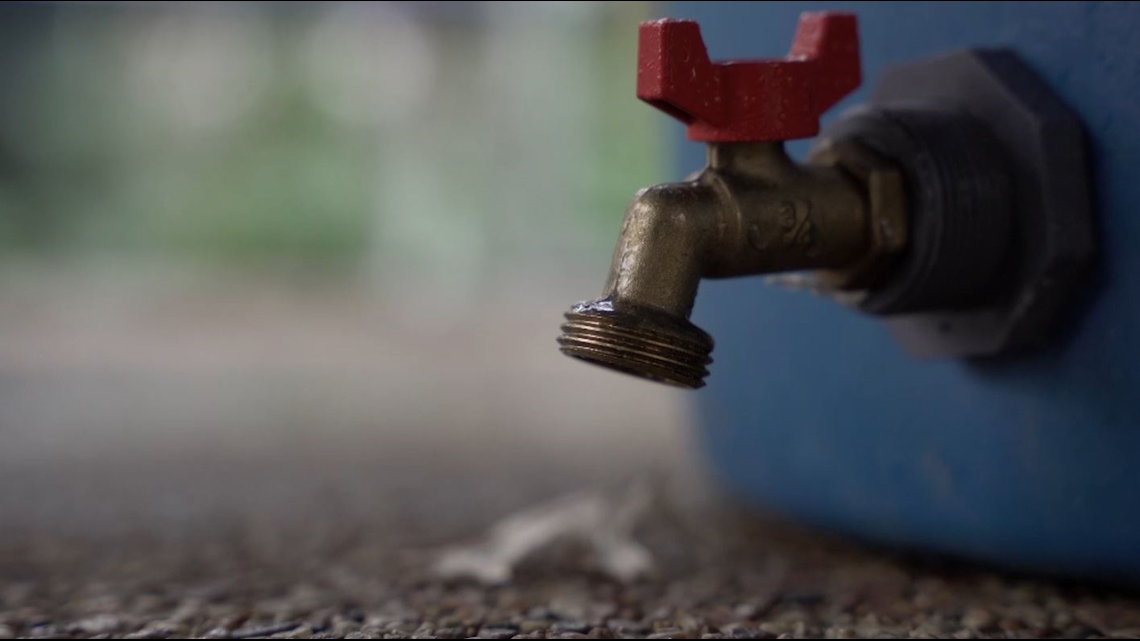
Chapter 4 The Future of North Texas Water
Both the North Texas Municipal Water District and the Upper Trinity Regional Water District are planning decades in advance for the community's water supply.
At NTMWD, they believe in water education and have an elementary school program called Water for Otter that encourages conservation among students.
As people in North Texas get wiser with how they use water, Covington said, NTMWD has been able to defer over $1 billion in capital expenditure.
She urges for continued conservation along these lines.
"One thing that we encourage all people to do is to use water wisely," said Covington. "Water is a limited resource that we need to conserve and make appropriate use of to ensure that it's available for future generations."
At UTRWD, Patterson sums it up quite simply: "Water is meaningful for life," he said.
"We encourage everyone to participate in local government activities, or study the water supply, the state water plan," Patterson said. "Texas is very unique in that we have long-term water supply plans that allow us to plan and coordinate with other agencies for a 50-year look-ahead, and they're updated through community action every five years."
After decades on the Lake Ralph Hall project, Patterson is looking forward to the day the UPRWD can start serving water to its customers.
"We will have plenty of water in the future," Woodson said. "All of our water providers are planning for that, and what’s going to happen with that is conservation."


